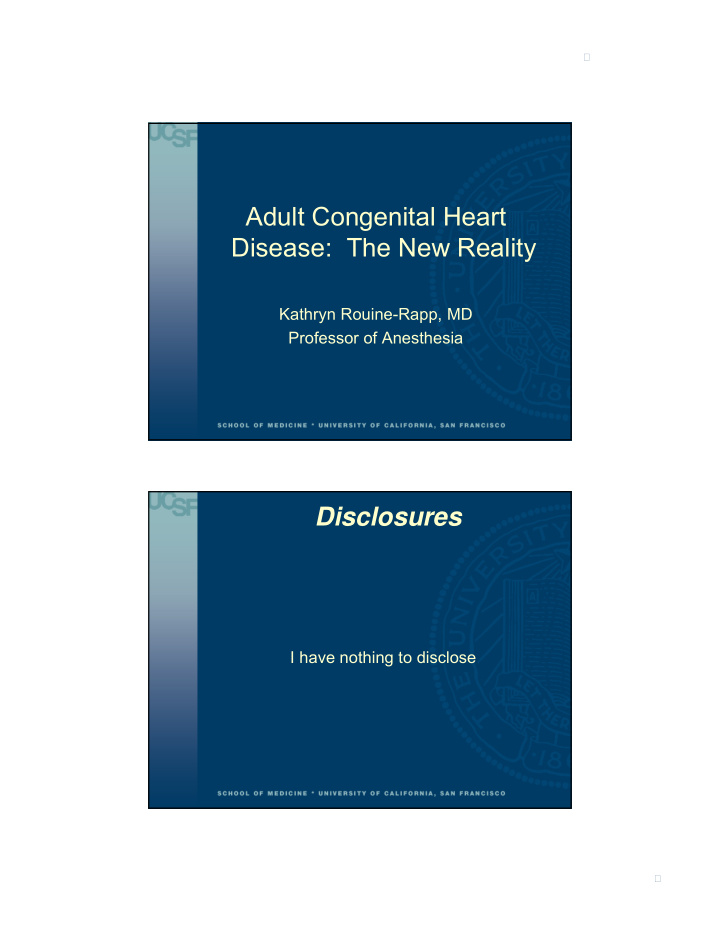



� 9/21/2015 Adult Congenital Heart Disease: The New Reality Kathryn Rouine-Rapp, MD Professor of Anesthesia Disclosures I have nothing to disclose � 1
� 9/21/2015 Outline � Historic perspective � Our reality � Common lesions � Guidelines � Pathways to expertise Lorraine Sweeney 1938 � PDA � First person to survive surgery to correct CHD � BCH � Dr. Robert Gros � 7 yo � 2
� 9/21/2015 Eileen Saxon 1944 � TOF � First person to undergo BT(T) shunt � Johns Hopkins � Drs Blalock, Taussig, & Mr Thomas � Age 15 months “switching arteries sidetracks blood and oxygen to otherwise starved lungs” � 3
� 9/21/2015 Our Reality � 1-3 million adults USA and CA with CHD � 1.8 million Europe � Survival to adulthood increased from 30% in 1940s to nearly 90% today � More adults vs children with CHD � Median age 40 yrs � FEBRUARY 23, 2014 � 4
� 9/21/2015 Our Reality � > 10000 adults with CHD � Increasing fraction of all non-cardiac surgery � Majority underwent surgery non- teaching hospitals � Increased morbidity and mortality � Maxwell et al. Anesthesiology. 2013 Oct; 119(4): 762- 9 Lesion classification � Complexity classification � Simple � Moderate � Severe � 20-25% overall severe complexity � 40% simple or “resolved” post intervention � 5
� 9/21/2015 Patient status � Unoperated � Palliated Surgical or device correction � � Excellent uncomplicated result � Residual defect � Sequelae � 6
� 9/21/2015 Lesions � Common lesions � VSD, ASD, PDA � Pulmonary valve stenosis � Aortic valve stenosis � Coarctation of the aorta � Atrioventricular-septal defects � TOF � TGA ASD One of most common defects Four types � Secundum (70% ) , central IAS, associated MR � Primum (15-25% ), near AV valves, associated cleft MV � Sinus venosus (10% ), associated w anomalous PV � Unroofed coronary sinus (rare) � 7
� 9/21/2015 � http://www.doctortipster.com/wp-content/uploads/2011/07/interatrial-septal-defect2.gif � https://apps.childrenshospital.org/clinical/mml/viewBLOB.cfm?MEDIA_ID=306 � 8
� 9/21/2015 Spectrum of severity 24 yo male asx athlete, murmur detected, secundum ASD 83 yo male, in OR for CABG, new “incidental” finding on TEE immediately prior to CPB, SV ASD & anomalous RUPV 54 yo female, presented with DOE and new onset atrial fibrillation with RVR, TTE w RVD, L to R ASD flow VSD � Four types � Perimembranous (70% ) � Muscular (20% ) � Doubly-committed (subarterial) (5% ) � Inlet (5% ) � 9
� 9/21/2015 � http://206.47.151.137/bcdecker/figures/acs/part11_ch01_fig29.gif Spectrum of severity � Large defects = heart failure/sx � Qp/Qs � pulmonary to systemic flow ratio � defect size � SVR and PVR � PHTN � Infective endocarditis � Device closure or surgery � 10
� 9/21/2015 Tetralogy of Fallot � Most common cyanotic defect � Four lesions � RVOTO (severity determines cyanosis) � RVH � VSD (PM) � Overriding aorta � http://www.heartbirthdefect.com/images/birth-defects/621x440xtetralogy-of-Fallot.jpg.pagespeed.ic.4Xfv8mG3um.jpg � 11
� 9/21/2015 Spectrum of severity � 61yo male for atrial flutter ablation � Shunt placement � Shunt revision and PM � Surgical repair (10yo) � Proximal LPA hypoplasia � Aneurysmal RVOT patch, PI � RV EF 30% � Decreasing exercise tolerance � Not a candidate for percutaneous intervention � 12
� 9/21/2015 Guidelines � 2008 ACC/AHA consensus statement � Adults with CHD : surgical (diagnostic, interventional) procedures that require general anesthesia or conscious sedation in adults with moderate or complex CHD should be performed in a regional adult CHD center with an anesthesiologist familiar with adult CHD patients Guidelines � 2008 ACC/AHA consensus statement � Adult patients with complex or high-risk CHD should be transferred to an adult CHD center for urgent or acute problems � …and should have a cardiologist consultation prior to procedures � 13
� 9/21/2015 Simple lesions � Unoperated � Operated � Isolated mild � PDA aortic or mitral � Secundum ASD valve lesion � Sinus venosus � Isolated ASD ASD wo residua � Small isolated VSD � VSD wo residua � Isolated mild PV stenosis � Cannesson et al Anesth 2009 Training � no established curriculum for education � DiNardo, Baum, Andropoulous: pathways for pediatric cardiac anesthesia fellowships depend on training prior to fellowship Anesth Analg. 2010 Apr 1;110(4):1121-5 � Inconsistent experience during adult cardiac anesthesia fellowships across USA (personal survey) � 14
� 9/21/2015 Closed claim analysis � Factors: adverse events n = 21 � 11 (52% ) cardiac procedures � 10 (48% ) noncardiac procedures � cardiac procedures � surgical technique (73% ) � intraoperative anesthetic care (55% ) � noncardiac cases � postoperative monitoring/ care (50% ) � CHD (50% ) � preoperative assessment or optimization (40% ) � Maxwell BG et al. Congenit Heart Dis. 2015 Jan-Feb;10(1):21-9 Questions to consider � Status of patient � Unoperated, palliated, repaired � Lesion and classification � Simple, moderate, severe complexity � Functional status � NYHA � Standard of care & experts in your group � When to say “no” � 15
� 9/21/2015 Summary � Increasing population of adults with CHD who need our care � Lesion classification � Specific lesions � Guidelines � Training variability � Reality of local care vs triage THANK YOU � 16
� 9/21/2015 � 17
� 9/21/2015 � 18
Recommend
More recommend